
Wine Culture and Information since 2002 - Volume 22
 Wine Culture and Information since 2002 - Volume 22 |
|
Issue 65, Summer 2008 |
Contents |
|
|
What is Wine? |
|
The question can sound silly and maybe it is silly indeed: whoever could answer - with no hesitation - to a simple question like that. And with even less hesitation would answer all the supporters of the beverage of Bacchus. Despite the apparent simplicity of a question like that, we believe the answer is not so easy, it is likely this is a question requiring many answers and not simple ones. Wine is a beverage, this is something we all probably agree on. However it is not a beverage like many: wine has played a cultural, traditional and, very often, ritual roles in the societies where it has been produced and is still produced today. Undoubtedly, wine is also a popular beverage, an indispensable support to the life of countryside people and of the areas committed to agriculture, in those places where wine has always been produced and it represented more than a simple beverage, even considered a “food”. Today the image of wine has radically changed, it probably had never got so much attention in the course of its history like the one it is getting in these times. Wine is discussed everywhere, among friends, in the press, television, radio, advertising: wine is everywhere. Not only wine is widely discussed: it frequently becomes a subject for the elite, one of those subjects giving people a more “intelligent” and “refined” dignity. Maybe they talked about wine too much, maybe in an inadequate way as well, most of the times using a language which made people staying away from wine instead of catching their attention. Certain terms and certain forms of language have indisputably contributed to make people believe wine is something complicated, something which cannot be understood, and sometimes - by reading some notes and some remarks - it seems they are talking about everything but wine. Ridiculous terms have only confused consumers, most of the times making them laugh. The reason of this interest is certainly associated to cultural and traditional factors, as well as passion, but it is indisputable one of the main factors responsible of such an interest is of economic nature. It would be silly to deny this: in the world of wine there are colossal economic interests - connected both to the production and the image as well - and it is therefore good this interest to stay alive. Whether there is an interest for wine, of course, it is something every supporter of the beverage of Bacchus wishes, however, when this interest becomes, like to say, spoiled, then the thing may also become disturbing. Experts of any sort - or presumed ones - make use of a showing off of knowledge, made of improbable and ridiculous words which make people staying away from wine instead of catching their interest. Nevertheless, wine, in its indisputable complexity, has the main quality of simplicity of immediateness and does not have any pretension but to give an emotion or to satisfy a need, according to one's point of view or to what one looks for in a wine. In this sense, it is almost impossible to resist to the temptation of mentioning the very funny sommelier character invented by the good comical actor Antonio Albanese: an intelligent caricature in which can be easily recognized the “ridiculous” behaviors of many “experts”. In this sense, Antonio Albanese has “hit the target”, although by making use of the licit exaggeration theater allows when it is needed to emphasize certain behaviors in order to make them ridiculous. Of course, we are not criticizing the professionalism and importance of sommeliers: their job, in case it is done with discretion, competence and, above all, savoir-faire, is certainly important for the spreading and knowledge of wine. It is however indisputable some “behaviors” make the people staying away from wine who, at the moment of choosing a wine, being afraid of making the wrong choice or to look like an inexpert, they avoid it and choose other simple beverages which do not need any complexity. What is therefore a wine? A beverage having its roots in tradition and culture, simple and immediate, or a beverage which must be complicated no matter what and distant from people? Maybe it is because it is needed “complicated” words in order to define a wine, to make use of ridiculous behaviors and to show off knowledge, that a wine is often considered complicated? Wine certainly is a complex beverage, but in its complexity, it can also be extremely simple: depends on what one looks for in a wine. One thing is however certain: as long as they will make of wine a complex beverage, according to a cultural and informative point of view, people will believe they are not capable of understanding it and they will therefore keep wine at a certain distance, something which distinguishes the ones who can appreciate it - but not the ones who abuse of it - and which cannot be understood. This does not however mean wine must be considered trivial or banal: the effect would be even worse, while increasing - maybe - the custom of making of it an excessive and deprecable use. However, also making of wine a beverage for the elite, complicated no matter what, it is not the best thing to do. Wine is a cultural and traditional heritage of the places where it has always been present in the life of people and, as such, must be heritage of everyone, not only of those who want to make wine into something different and that with wine has nothing in common. Words are important, they have the primary function of allowing everyone to understand a concept, not to make it incomprehensible. In case something is incomprehensible, therefore it is also useless: no one knows what to do with something he or she does not understand or does not know how to use it. He or she may probably pretend to understand it or to use it, and, of course, this is not the same thing and it is not useful to the spreading of wine culture. Because wine is culture, because wine is simply wine.
|
||||
Comparing Nero d'AvolaThe king of Sicilian red berried grapes, Nero d'Avola, has given notoriety to the wines of this Italian island everywhere in the world, wines capable of elegance, strength and complexity |
|
Talking about the red wines of Sicily means, first of all, talking about Nero d'Avola, a grape which is now renowned everywhere in the world and which allowed the enology of the island to get excellent results. Widely found in red wines of the region, Nero d'Avola is used both alone and blended with other red grapes, frequently with “international” grapes such as Cabernet Sauvignon, Merlot and Syrah. Among the autochthonous grapes of Sicily, Nero d'Avola is mainly added to Frappato - as in the case of Cerasuolo di Vittoria - Perricone, Nerello Cappuccio and Nerello Mascalese. When used alone, Nero d'Avola produces wines of good body, as well as with a full body, and - because of its appreciable quantity of sugar - wines with pretty high alcohol volumes and which can also reach 15%. For this reason, in the past Nero d'Avola was mainly used to “strengthen” other light wines. The origins of Nero d'Avola are not clear. To make things even harder contribute the many names with which the grapes is known in Sicily, of which the most common one is Calabrese. This name, which could make one think about an origin from Calabria region, is not confirmed by facts, as Nero d'Avola is absent from this region and it is exclusively found in the territory or Sicily. It seems the term “calabrese” comes from the name of an ancient Sicilian noble family. According to other theories, the term calabrese comes from the Italianization of the dialectal Sicilian term calarvisi, that is “grape from Avola”, an hypothesis which could be reinforced by the present name of the grape and recognizing its origin from the city of Avola, in province of Siracusa. Among the most used names to call Nero d'Avola, the most common ones are Calabrese Nero, Calabrese Pizzutello and Calabrese Dolce.
|
|
Nero d'Avola is virtually found in all the territory of Sicily and it is used for the production of many red wines of Denominazione di Origine Controllata DOC. Nero d'Avola is characterized by a large leaf, with clusters of average size and with a conic shape. Also the berry is of average size, with an oval or ellipsoidal shape, with thick and resistant skin, of bluish color because of the abundant presence of bloom. Thanks to its characteristic, Nero d'Avola is very suited to the aging in cask or barrique - and this is in fact the most common choice among wine makers - and generally makes wines which can stand to long periods of aging. Because of its quantity of sugar, wines produced with Nero d'Avola tend to have a pretty high alcohol volume, a characteristic forcing viticulturists and wine makers to strict productive practices in order to limit the development of sugar.
Our comparative tasting dedicated to Nero d'Avola, makes use of three wines produced with this grape only and classified as Indicazione Geografica Tipica IGT. The first wine of our comparative tasting is Firriato's Harmonium, produced with 100% Nero d'Avola and aged for 10 months in barrique. Also the second wine of the tasting is produced with 100% Nero d'Avola - Morgante's Don Antonio - and, as opposed to the previous wines, aged for a longer period, 12 months in barrique. The third wine of the tasting is Duca di Salaparuta's Duca Enrico, also in this case aged in barrique although for a longer period of 18 months. The three wines will be served at a temperature of 18° C (65° F) and will be used the vintages currently available in shops. The tasting - as usual - will be done by using three ISO tasting glasses.
|
||||||||
|
Nero d'Avola has a good coloring property, therefore the wines produced with this grape will tend to have pretty intense colors and low transparencies. As usual, these factors are widely determined by the quality of cultural techniques as well as by wine making practices used in cellar. Thanks to its characteristics, wines produced with Nero d'Avola can stand to years of aging in bottle, therefore also the development of color over time is a quality to be considered in these wines. During their youth, Nero d'Avola wines show intense and brilliant ruby red colors, sometimes being deep as well, with a transparency from moderate to low, a quality which is also determined by the aging in wood. With time, ruby red leaves space to garnet red - also in nuances - and transparency will increase because of the sedimentation of coloring substances. Let's begin the evaluation of appearance from Firriato's Harmonium. By holding the glass tilted over a white surface - a sheet of paper or a white napkin is enough - we will appreciate the color and its nuances. At the base of the glass, where the thickness of wine is greater, it will be noticed an intense and deep ruby red color, with a pretty low transparency, confirming the good coloring properties of Nero d'Avola. By observing the wine towards the opening of the glass, in the point of minimum thickness, we will evaluate nuances, in this case ruby red. Let's now evaluate the appearance of Morgante's Don Antonio: the color of this second wine is intense and deep ruby red and, just like the previous wine, with a pretty low transparency. As opposed to the previous wine, the nuances of this Nero d'Avola already show a garnet red hue. Let's now pass to the examination of the last wine of the comparative tasting: Duca di Salaparuta's Duca Enrico. The color of this Nero d'Avola is intense ruby red with garnet red nuances and, just like the previous wines, also in this case transparency is pretty low.
|
|
The evaluation of aromas in Nero d'Avola gives the nose of the taster an interesting sensorial experience. Thanks to its good predisposition to the vinification in wood, wines produced with Nero d'Avola are generally characterized by a pretty complex tertiary profile. Despite the vinification of Nero d'Avola is mainly made in wood containers - casks or barriques - in some cases producers choose inert containers, such as steel tanks, therefore favoring the aromatic qualities of fruits and flowers of the grape. Among the most frequent fruit aromas and typical in Nero d'Avola are mentioned black cherry, blackberry, plum and blueberry. As for the world of flowers, the role of protagonist in wines produced with Nero d'Avola is played by violet. With time, Nero d'Avola can develop complex aromas such as leather, cocoa, chocolate, carob, licorice and cinnamon, as well as balsamic aromas of menthol and eucalyptus. Let's begin the evaluation of the olfactory profile of the wines of our comparative tasting from Firriato's Harmonium. By holding the glass in vertical position and without swirling, let's proceed with the first smell, which will allow the evaluation of opening aromas, that is the aromatic qualities identifying the wine and made of lighter molecules. From the glass will emerge intense and clean aromas of blackberry, black cherry and plum, a pretty typical opening of Nero d'Avola. After having swirled the glass, in order to favor the development of the other aromatic qualities - that is the ones made of heavy molecules, we will proceed with another smell, therefore completing the olfactory profile of this first wine. From the glass will be perceived aromas of violet and blueberry, as well as complex aromas of vanilla, carob, cocoa, licorice, tobacco and pleasing hints of cardamom and black pepper. It should finally be noticed the pleasing balsamic touch of menthol. Let's now proceed with the second wine: Morgante's Don Antonio. Also the opening of this second Nero d'Avola confirms the qualities of the renowned red berried grape of Sicily: from the glass are in fact perceived intense and pleasing aromas of black cherry, blackberry and plum with an intensity and a balance similar to the previous wine. After having swirled the glass, we will do another smell, therefore completing the olfactory profile of the wine. From the glass will emerge aromas of violet, blueberry and cyclamen, as well as complex aromas of vanilla, carob, tobacco, licorice and pink pepper, including the pleasing balsamic touch of menthol. Let's now pass to Duca di Salaparuta's Duca Enrico. The opening of this third wine is characterized by black cherry, plum and blackberry, just like the previous wines and typical in Nero d'Avola. The olfactory sequence of Duca Enrico, after having swirled the glass, will be completed by aromas of violet and blueberry to which will be added the complex sensations of vanilla, tobacco, chocolate, cinnamon, licorice, pink pepper and the usual balsamic touch of menthol.
|
||||
|
Nero d'Avola is a grape characterized by a good content in sugar, a quality which inevitably gives a production of wines with pretty high alcohol volumes, values which can also easily reach 15%. For this reason, Nero d'Avola requires viticultural and wine making practices suited for the limitation of this characteristic, most of the times limited by adding other red grapes in order to mitigate its strength. Besides the appreciable content in alcohol, wines produced with Nero d'Avola are characterized by a good structure, thanks to the presence of tannins, including the ones extracted from the wood during the aging period. In this sense, the alcohol of Nero d'Avola is useful for balancing the astringency in its wines, a balance which is also obtained by the roundness given by the aging in cask. In wines produced with Nero d'Avola, correspondence is pretty good, in particular the sensations of black cherry, plum and blackberry. Let's begin the gustatory evaluation from the first wine of our comparative tasting: Firriato's Harmonium. The attack of this Nero d'Avola is tannic, even though well balanced both by alcohol and the roundness given by the aging in wood, in this case, 10 months in barrique. The structure is evidently full and robust, however not unsuited for the style of this wine. Let's now pass to Morgante's Don Antonio. The attack of this second wine is tannic, however well balanced both by alcohol and roundness given by the aging in wood, with a very good correspondence to the nose, in particular blackberry and plum. The structure is full and robust. The gustatory evaluation of the third wine - Duca di Salaparuta's Duca Enrico - confirms what has been found in previous wines. The attack is tannic, with a full body, well balanced both by alcohol and roundness given by the aging in wood. It should also be noticed the good correspondence of this wine to the nose.
|
|
Nero d'Avola - a grape considered in past being of scarce value and destined to the blending with other grapes - thanks to quality viticultural and wine making practices, today proves its indisputable value with the excellence of its wines. The finish of Firriato's Harmonium is very persistent with long and pleasing flavors of black cherry, blackberry and plum, very clean. Also the finish of Morgante's Don Antonio is very persistent, leaving in the mouth long and clean flavors of black cherry, blackberry and plum, not so different from the previous wines. The finish of the third wine of our comparative tasting - Duca di Salaparuta's Duca Enrico - confirms the good sensations of the previous Nero d'Avola wines, with a long persistence characterized by clean and intense flavors of black cherry, plum and blackberry, very correspondent to the aromas perceived to the nose and very pleasing. It should also be noticed the balance between the robust perception of structure and roundness which can be perceived in all of the three wines after having swallowed the sample.
|
Wines of the Month |
|
|
|
Score legend Prices are to be considered as indicative. Prices may vary according to the country or the shop where wines are bought |
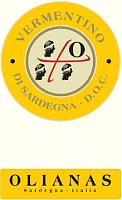
|
|
Vermentino di Sardegna 2006 |
|
| Olianas (Sardinia, Italy) | |
| Grapes: Vermentino | |
| Price: € 10.00 | Score: |
| This Vermentino di Sardegna shows a brilliant straw yellow color and nuances of straw yellow, very transparent. The nose denotes intense, clean and pleasing aromas that start with hints of apple, plum and pear followed by aromas of hawthorn, citrus fruits and almond. The mouth has good correspondence to the nose, a crisp attack and however balanced by alcohol, good body, intense flavors. The finish is persistent with flavors of apple, plum and almond. This wine ages in steel tanks. | |
| Food Match: Fish appetizers, Pasta and risotto with fish, Sauteed fish | |
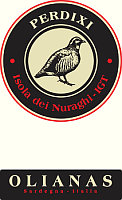
|
|
Perdixi 2005 |
|
| Olianas (Sardinia, Italy) | |
| Grapes: Cannonau (30%), Alicante (35%), Bovale (35%) | |
| Price: € 15.00 | Score: |
| Perdixi shows a brilliant ruby red color and nuances of ruby red, moderate transparency. The nose denotes intense, clean, pleasing and refined aromas which start with hints of plum, black cherry and raspberry followed by aromas of violet, cyclamen, vanilla, tobacco, pink pepper, chocolate and menthol. The mouth has good correspondence to the nose, a tannic attack and however balanced by alcohol, good body, intense flavors, agreeable. The finish is persistent with flavors of black cherry and plum. Perdixi ages in barrique for 8 months. | |
| Food Match: Roasted meat, Broiled meat and barbecue, Stewed meat, Hard cheese | |
|
|
|
Bianco della Congiura 2006 |
|
| Castello del Trebbio (Tuscany, Italy) | |
| Grapes: Riesling (50%), Pinot Grigio (20%), Incrocio Manzoni 6.0.13 (20%), Viognier (10%) | |
| Price: € 12.00 | Score: |
| Bianco della Congiura shows a brilliant straw yellow color and nuances of straw yellow, very transparent. The nose denotes intense, clean and pleasing aromas that start with hints of apple, plum and peach followed by aromas of acacia, hawthorn and pear. The mouth has good correspondence to the nose, a crisp attack and however balanced by alcohol, good body, intense flavors. The finish is persistent with flavors of apple, plum and peach. Bianco della Congiura ages in steel tanks. | |
| Food Match: Crustacean and vegetable appetizers, Risotto with crustaceans and vegetable, Vegetable soup | |
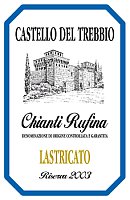
|
|
Chianti Rufina Riserva Lastricato 2003 |
|
| Castello del Trebbio (Tuscany, Italy) | |
| Grapes: Sangiovese | |
| Price: € 15.00 | Score: |
| Chianti Rufina Riserva Lastricato shows a brilliant ruby red color and nuances of garnet red, moderate transparency. The nose denotes intense, clean, pleasing and refined aromas that start with hints of black cherry, plum and violet followed by aromas of raspberry, vanilla, tobacco, cocoa, cinnamon, licorice and menthol. The mouth has good correspondence to the nose, a tannic attack and however balanced by alcohol, good body, intense flavors. The finish is persistent with flavors of black cherry, plum and raspberry. Chianti Rufina Riserva Lastricato ages for 20 months in cask. | |
| Food Match: Roasted meat, Braised and stewed meat with mushrooms, Hard cheese | |
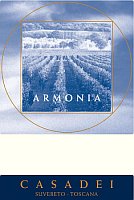
|
|
Armonia 2005 |
|
| Casadei (Tuscany, Italy) | |
| Grapes: Sangiovese, Alicante, Syrah | |
| Price: € 10.00 | Score: |
| Armonia shows an intense ruby red color and nuances of ruby red, moderate transparency. The nose denotes intense, clean, pleasing and refined aromas which start with hints of black cherry, plum and blueberry followed by aromas of black currant, violet, vanilla, pink pepper, chocolate and menthol. The mouth has good correspondence to the nose, a tannic attack and however balanced by alcohol, good body, intense flavors. The finish is persistent with flavors of black cherry, plum and blueberry. Armonia ages for 12 months in barrique. | |
| Food Match: Roasted meat, Stewed meat with mushrooms, Broiled meat and barbecue | |
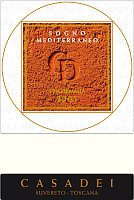
|
|
Sogno Mediterraneo 2005 |
|
| Casadei (Tuscany, Italy) | |
| Grapes: Sangiovese, Syrah, Alicante, Petit Verdot, Cabernet Sauvignon, Merlot | |
| Price: € 18.00 | Score: |
| Sogno Mediterraneo shows an intense ruby red color and nuances of ruby red, little transparency. The nose denotes intense, clean, pleasing and refined aromas that start with hints of black cherry, plum and black currant followed by aromas of blueberry, geranium, blackberry, green bean, violet, carob and vanilla. The mouth has good correspondence to the nose, a tannic attack and however balanced by alcohol, good body, intense flavors. The finish is persistent with flavors of black cherry, plum and blueberry. Sogno Mediterraneo ages for 14 months in barrique followed by at least 7 months of aging in bottle. | |
| Food Match: Roasted meat, Broiled meat and barbecue, Stewed and braised meat with mushrooms | |
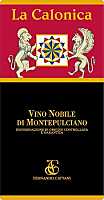
|
|
Vino Nobile di Montepulciano Riserva 2004 |
|
| La Calonica (Tuscany, Italy) | |
| Grapes: Sangiovese (90%), Canaiolo Nero (5%), Merlot (5%) | |
| Price: € 21.00 | Score: |
| Vino Nobile di Montepulciano Riserva shows a brilliant ruby red color and nuances of garnet red, little transparency. The nose reveals intense, clean, pleasing and refined aromas which start with hints of black cherry, plum and blueberry followed by aromas of violet, vanilla, cocoa, cinnamon, tobacco, clover and menthol. The mouth has good correspondence to the nose, a tannic attack and however balanced by alcohol, full body, intense flavors. The finish is persistent with flavors of black cherry, plum and blueberry. Vino Nobile di Montepulciano Riserva ages in cask for 36 months followed by 6 months of aging in bottle. | |
| Food Match: Game, Roasted meat, Braised and stewed meat, Hard cheese | |
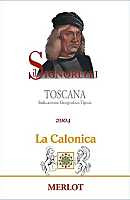
|
|
Signorelli 2003 |
|
| La Calonica (Tuscany, Italy) | |
| Grapes: Merlot | |
| Price: € 30.00 | Score: |
| Signorelli shows an intense ruby red color and nuances of garnet red, little transparency. The nose reveals intense, clean, pleasing, refined and elegant aromas which start with hints of black cherry, black currant and plum followed by aromas of blackberry, violet, vanilla, pink pepper, chocolate, cinnamon, leather and menthol. The mouth has good correspondence to the nose, a tannic attack and however balanced by alcohol, full body, intense flavors, pleasing roundness. The finish is persistent with flavors by black cherry, plum and black currant. A well made wine. Signorelli ages for 16 months in barrique followed by 12 months of aging in bottle. | |
| Food Match: Game, Roasted meat, Braised and stewed meat, Hard cheese | |
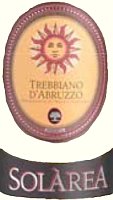
|
|
Trebbiano d'Abruzzo Solarea 2006 |
|
| Agriverde (Abruzzo, Italy) | |
| Grapes: Trebbiano d'Abruzzo | |
| Price: € 18.00 | Score: |
| Trebbiano d'Abruzzo Solarea shows an intense straw yellow color and nuances of straw yellow, very transparent. The nose reveals intense, clean, pleasing and refined aromas which start with hints of apple, plum and pineapple followed by aromas of vanilla, honey, almond, hawthorn, pear and grapefruit. The mouth has good correspondence to the nose, a crisp attack and however balanced by alcohol, good body, intense flavors, pleasing roundness. The finish is persistent wit flavors of apple, plum and grapefruit. Trebbiano d'Abruzzo Solarea ages for 18 months in cask. | |
| Food Match: Roasted fish, Stewed fish, Roasted white meat | |
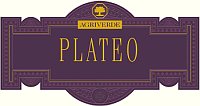
|
|
Montepulciano d'Abruzzo Plateo 2001 |
|
| Agriverde (Abruzzo, Italy) | |
| Grapes: Montepulciano | |
| Price: € 29.40 | Score: |
| Montepulciano d'Abruzzo Plateo shows a deep ruby red color and nuances of garnet red, impenetrable to the light. The nose reveals intense, clean, pleasing, refined and elegant aromas which start with hints of black cherry, blackberry and plum followed by aromas of dried violet, blueberry, vanilla, tobacco, licorice, chocolate, cinnamon, leather, mace and menthol. The mouth has excellent correspondence to the nose, a tannic attack and however balanced by alcohol, full body, intense flavors, pleasing smoothness. The finish is very persistent with long flavors of black cherry, blackberry and plum. A well made wine. Montepulciano d'Abruzzo Plateo ages for 24 months in steel tanks, 24 months in barrique and 24 months in bottle. | |
| Food Match: Game, Roasted meat, Braised and stewed meat, Hard cheese | |
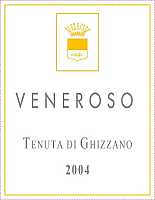
|
|
Veneroso 2004 |
|
| Tenuta di Ghizzano (Tuscany, Italy) | |
| Grapes: Sangiovese (70%), Cabernet Sauvignon (30%) | |
| Price: € 21.00 | Score: |
| Veneroso shows a brilliant ruby red color and nuances of garnet red, moderate transparency. The nose denotes intense, clean, pleasing and refined aromas that start with hints of plum, black cherry and black currant followed by aromas of blueberry, violet, blackberry, vanilla, tobacco, chocolate, cinnamon and mace. The mouth has good correspondence to the nose, a tannic attack and however balanced by alcohol, good body, intense flavors, pleasing roundness. The finish is persistent with flavors of black cherry, plum and blueberry. Veneroso ages for 16 months in barrique followed by 12 months of aging in bottle. | |
| Food Match: Roasted meat, Stewed and braised meat, Hard cheese | |
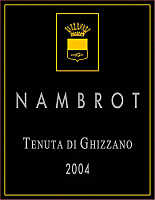
|
|
Nambrot 2004 |
|
| Tenuta di Ghizzano (Tuscany, Italy) | |
| Grapes: Merlot (70%), Cabernet Sauvignon (20%), Petit Verdot (10%) | |
| Price: € 32.00 | Score: |
| Nambrot shows an intense ruby red color and nuances of garnet red, little transparency. The nose reveals intense, clean, pleasing, refined and elegant aromas which start with hints of black cherry, plum and black currant followed by aromas of blueberry, violet, vanilla, tobacco, blackberry, pink pepper, chocolate, mace, black pepper and eucalyptus. The mouth has excellent correspondence to the nose, a tannic attack and however balanced by alcohol, full body, intense flavors, pleasing roundness. The finish is very persistent with long flavors of black cherry, plum and black currant. A well made wine. Nambrot ages for 18 months in barrique. | |
| Food Match: Game, Roasted meat, Braised and stewed meat, Hard cheese | |
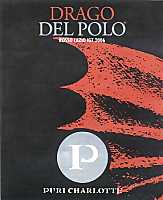
|
|
Drago del Polo 2006 |
|
| Charlotte Puri (Latium, Italy) | |
| Grapes: Aleatico | |
| Price: € 9.00 - 50cl | Score: |
| Drago del Polo shows a brilliant ruby red color and nuances of ruby red, moderate transparency. The nose denotes intense, clean and pleasing aromas that start with hints of strawberry, raspberry and cyclamen followed by aromas of geranium, cherry, blueberry and rose. The mouth has good correspondence to the nose, a sweet attack and slight astringency, pleasing crispness, however balanced by alcohol, good body, intense flavors. The finish is persistent with flavors of strawberry, raspberry and cherry. Drago del Polo Drago del Polo ages for 6 months in bottle. | |
| Food Match: Fruit and jam tarts | |
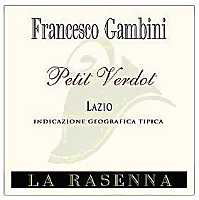
|
|
Petit Verdot 2006 |
|
| La Rasenna (Latium, Italy) | |
| Grapes: Petit Verdot | |
| Price: € 8.00 | Score: |
| This Petit Verdot shows an intense ruby red color and nuances of ruby red, little transparency. The nose reveals intense, clean, pleasing and refined aromas that start with hints of black cherry, plum and black currant followed by aromas of violet, vanilla, carob and menthol. The mouth has good correspondence to the nose, a tannic attack and however balanced by alcohol, good body, intense flavors. The finish is persistent with flavors of black cherry, plum and black currant. This Petit Verdot ages in cask. | |
| Food Match: Stewed meat with mushrooms, Roasted meat, Broiled meat and barbecue | |
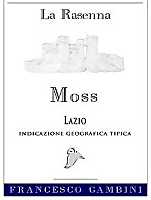
|
|
Moss 2007 |
|
| La Rasenna (Latium, Italy) | |
| Grapes: Moscato d'Alessandria (60%), Sauvignon Blanc (40%) | |
| Price: € 6.50 | Score: |
| Moss shows an intense straw yellow color and nuances of straw yellow, very transparent. The nose denotes intense, clean, pleasing and refined aromas which start with hints of grape, peach and pear followed by aromas of nettle, elder, apple, pineapple and sage. The mouth has good correspondence to the nose, a crisp attack and however balanced by alcohol, good body, intense flavors, agreeable. The finish is persistent with flavors of grape, peach and pineapple. Moss ages for 4 months in steel tanks followed by one month of aging in bottle. | |
| Food Match: Fish appetizers, Pasta and risotto with fish and crustaceans, Fried fish | |

|
|
Grechetto 2007 |
|
| Saio (Umbria, Italy) | |
| Grapes: Grechetto | |
| Price: € 4.80 | Score: |
| This wine shows an intense greenish yellow color and nuances of greenish yellow, very transparent. The nose denotes intense, clean and pleasing aromas which start with hints of apple, plum and hazelnut followed by aromas of hawthorn, pear and anise. The mouth has good correspondence to the nose, a crisp attack and however balanced by alcohol, good body, intense flavors. The finish is persistent with flavors of apple, pear and plum. This Grechetto ages in steel tanks. | |
| Food Match: Fish and vegetable appetizers, Pasta and risotto with fish and crustaceans, Fried fish | |
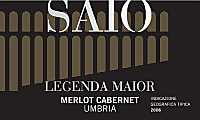
|
|
Legenda Maior 2006 |
|
| Saio (Umbria, Italy) | |
| Grapes: Merlot, Cabernet Sauvignon | |
| Price: € 12.00 | Score: |
| Legenda Maior shows a brilliant ruby red color and nuances of ruby red, little transparency. The nose reveals intense, clean, pleasing and refined aromas which start with hints of black cherry, plum and black currant followed by aromas of blueberry, blackberry, violet, vanilla, cocoa and mace. The mouth has good correspondence to the nose, a tannic attack and however balanced by alcohol, good body, intense flavors, agreeable. The finish is persistent with flavors of black cherry, plum and black currant. Legenda Maior ages for 8 months in barrique followed by 3 months of aging in bottle. | |
| Food Match: Roasted meat, Stewed and braised meat, Broiled meat and barbecue | |
News |
|
In this section are published news and information about events concerning the world of wine and food. Whoever is interested in publishing this kind of information can send us a mail to our address.
|
AquavitaeReview of Grappa, Distillates and Brandy |
|
|
| Distillates are rated according to DiWineTaste's evaluation method. Please see score legend in the "Wines of the Month" section. |
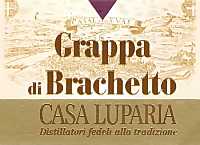
|
|
Grappa di Brachetto |
|
| Casa Luparia (Piedmont, Italy) | |
| Raw matter: Pomace of Brachetto | |
| Price: € 11.50 - 50cl | Score: |
| This grappa is limpid, crystalline and colorless. The nose denotes intense, clean, pleasing and refined aromas of grape, strawberry, raspberry, cherry, rose and blueberry, with almost imperceptible alcohol pungency. In the mouth has intense flavors, with perceptible alcohol pungency which tends to dissolve rapidly, good correspondence to the nose, balanced sweetness, good roundness, agreeable. The finish is persistent with flavors of strawberry, cherry and raspberry. A well made grappa produced with a discontinuous alembic still operating at low pressure. Alcohol 42%. | |
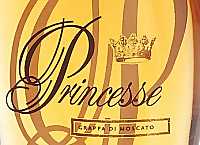
|
|
Grappa Stravecchia di Moscato 3 Anni Princesse |
|
| Casa Luparia (Piedmont, Italy) | |
| Raw matter: Pomace of Muscat Blanc | |
| Price: € 90.00 - 70cl | Score: |
| This grappa shows a pale golden yellow color, limpid and crystalline. The nose reveals intense, clean, pleasing, refined and elegant aromas of grape, peach, vanilla, honey, hazelnut, dried fig, tobacco and chocolate, with almost imperceptible alcohol pungency. In the mouth has intense flavors, with perceptible alcohol pungency which tends to dissolve rapidly, excellent correspondence to the nose, balanced sweetness, pleasing smoothness. The finish is very persistent wit long flavors of grape, peach, honey and hazelnut. A well made grappa produced with a discontinuous alembic still operating at low pressure. It ages for 3 years in oak casks. Alcohol 42%. | |
Wine Parade |
|
|
| The best 15 wines according to DiWineTaste's readers. To express your best three wines send us an E-mail or fill in the form available at our WEB site. |
| Rank | Wine, Producer | |
|---|---|---|
| 1 |
| Bradisismo 2003, Inama (Italy) |
| 2 |
| San Leonardo 2001, Tenuta San Leonardo (Italy) |
| 3 |
| Wine Obsession 2001, Vignamaggio (Italy) |
| 4 |
| Barolo Bussia 2001, Prunotto (Italy) |
| 5 |
| Chianti Classico Riserva Novecento 2000, Dievole (Italy) |
| 6 |
| Collio Bianco Col Disôre 2004, Russiz Superiore (Italy) |
| 7 |
| Blanc des Rosis 2006, Schiopetto (Italy) |
| 8 |
| Barolo Cannubi Boschis 2001, Sandrone (Italy) |
| 9 |
| Sforzato di Valtellina San Domenico 2002, Triacca (Italy) |
| 10 |
| Amarone della Valpolicella Classico 2000, Zenato (Italy) |
| 11 |
| Aglianico del Vulture La Firma 2004, Cantine del Notaio (Italy) |
| 12 |
| Sangiovese di Romagna Superiore Riserva Thea 2005, Tre Monti (Italy) |
| 13 |
| Sforzato di Valtellina Canua 2001, Conti Sertoli Salis (Italy) |
| 14 |
| Sagrantino di Montefalco Collepiano 2003, Arnaldo Caprai (Italy) |
| 15 |
| Soave Classico Monte Alto 2004, Ca' Rugate (Italy) |
| |||||||
Privacy Policy | |||||||


| Copyright © 2002-2024 Antonello Biancalana, DiWineTaste - All rights reserved |
| All rights reserved under international copyright conventions. No part of this publication and of this WEB site may be
reproduced or utilized in any form or by any means, electronic or mechanical, without permission in writing from DiWineTaste. |